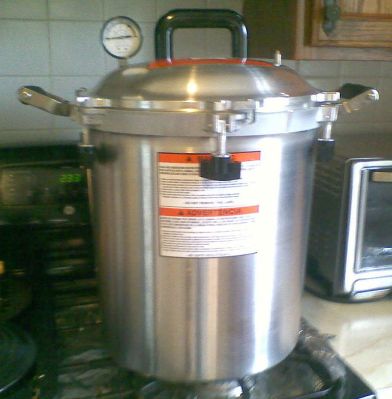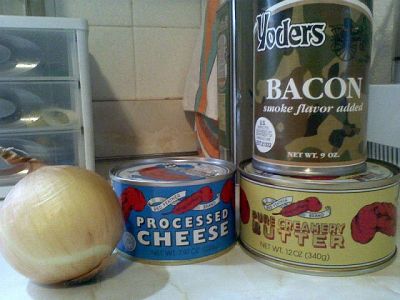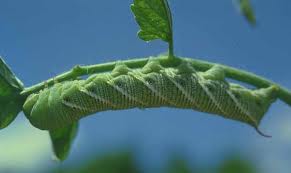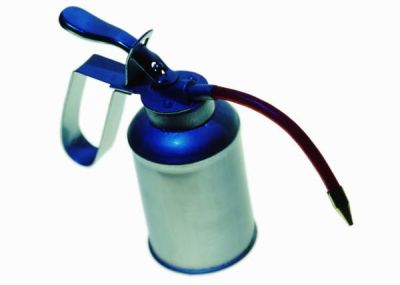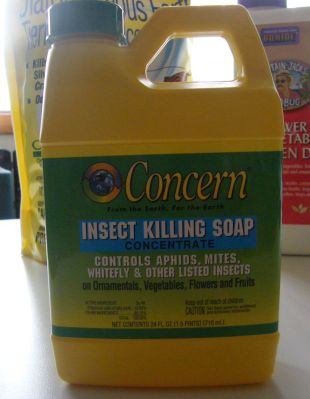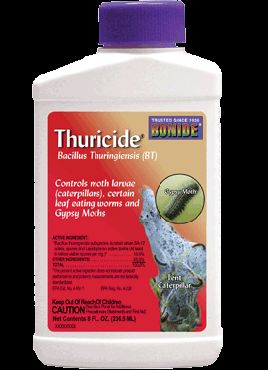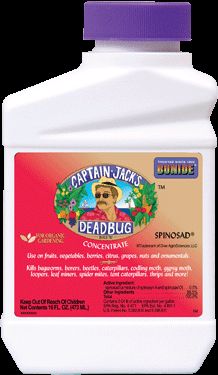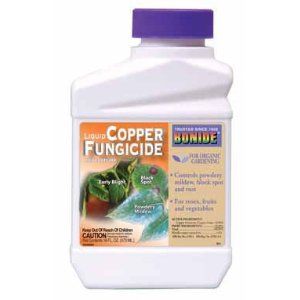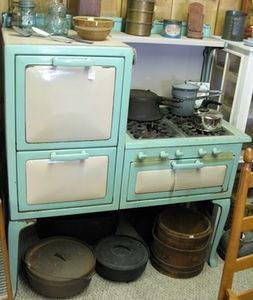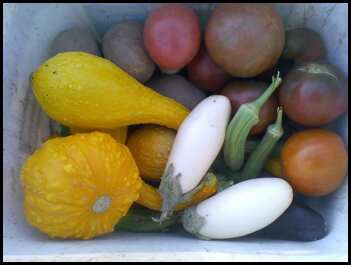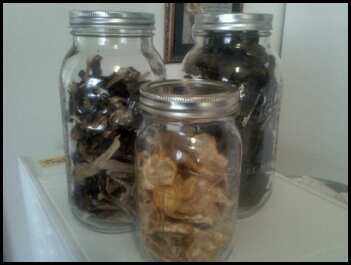My husband just alerted me to this little item of recent news:
http://www.kplu.org/post/home-canning-hobby-leads-near-fatal-medical-emergency
Now that the gardens are producing a harvest, the canning and preserving season is upon us. I’ve already canned eight quarts of Callaloo (Amaranth) Greens, six quarts of Kale Greens, 10 Quarts of Green and Yellow Wax beans, and I have frozen about 10 Pounds of Cabbage. I have also harvested about a peck of Eggplants (didn’t can em because we ate em! Recipe below. . .), and we have dug about 10 pounds of potatoes, and a bushel of onions.
When I read the article above, I thought I’d write a little reminder about CANNING stuff. I sure hope that people AREN’T dusting off their old canning recipes, and I hope that people ARE using the correct equipment and recipes! No cutting of corners allowed! This fellow didn’t, and nearly lost his life. . .
What really bothers me is that the title of this article gives the impression that Home Canning is in and of itself a dangerous activity that will result in poisoning. The comments by this man’s daughter that there will be “no more canning” also lends credence to this wrongful statement. What it actually should have said is that ERRORS made in Home Canning Hobby Leads to Near-Fatal Medical Emergency. I have been canning for years, and I am currently waiting for Penn State University to let me know when their next Master Preserver class will be. While I wait, I am taking an online class offered by the National Center for Home Food Preservation. I can both vegetables and meats, and I am constantly warning people to rely ONLY on scientifically tried and true recipes when canning. Canning is not the time to cut any corners at all, nor is it the time to display your prowess as a gourmet cook. Foods are best canned SIMPLY, and one can then use them in fancy recipes LATER, after they are decanted. If the man named in the above article had followed the recommendations of the Ball Blue Book and the National Center for Home Food Preservation, he would have had no problems. Elk (and venison) is to be canned for 90 minutes (quart jars) at 10 pounds pressure in a weighted gauge canner or 11 pounds pressure in a dial gauge canner (at elevations of 1000 feet above sea level or less), or at 75 minutes (pints) at 10 pounds pressure (weighted gauge) or 11 pounds pressure (dial gauge), elevations of 1000 feet above sea level or less.
Please notice that in this recipe as in ALL canning recipes, the size of the jar, the type of pressure canner and the altitude of your town or city are all important considerations to the process. For example, higher altitudes require longer processing times. (For your information, Harrisburg is 320 feet above sea level.) No exceptions and no shortcuts are allowed in this recipe and it may never be altered in any way. This is also the correct recipe for canning beef. Home canning is safe, enjoyable and economical, but only if you follow the rules.
This is my pride and joy, my beautiful new All American Pressure canner. This beauty can CAN up to 14 quarts of food at a time. . .
It is perfectly safe to borrow or buy a used canner, but your first trip should be to your local University or College Extension service to have the Dial Gauge canner pressure-tested for safety. If you buy or borrow a used Weighted Gauge Pressure Canner, you do not need to have it tested, but you must buy all new working parts for it, for safety (the working parts include the rubber gasket or sealing ring, the overpressure plug, the vent pipe assembly and the interlock assembly). You do not have to replace the Weighted Gauge. These parts are not really that expensive. If you own any type of Pressure Canner it really is a good idea to replace all of the parts every other year anyway. You should also never DROP a canner, and you should never use a canner that is dented or warped. Here’s a good place to buy replacement parts:
http://www.pressurecooker-outl…
I also want to remind everyone that according to the USDA, any canning recipe OLDER than 1988 is DANGEROUS. The old recipes that Mom and Grandma may have used are not good. You CANNOT preserve Corn, Greens and Green Beans in a boiling water bath canner. No matter how long you boil them at 212 degrees, the food will not be safe to eat. It will not be safe, even if you boil it all over again before eating it. The Botulism Bacteria cannot be boiled away. The man in the article mentioned above learned this to his sorrow. There are no recipes for canning low acid foods such as meats and vegetables in a boiling water bath canner. I do have a 100-year-old cookbook that does give some times for canning stuff like corn in a boiling water bath, but I will never give out that information to anyone. The fact is that these recipes were no good back then, but people simply took a chance because there was no better information available. Please don’t use or rely on any “old fashioned” recipes. The Ball Blue Book, which is actually sold in the Giant and Karns Supermarkets, is fairly inexpensive (about $5) and reliable. Also, you can get recipes for FREE from the National Center for Home Food Preservation website. Don’t take foolish chances!
Also, you must stick to the types of jars and lids indicated here:
http://nchfp.uga.edu/how/general/recomm_jars_lids.html
Currently, the so-called “reusable” canning lids are not recommended due to problems with seal failure.
Speaking of used canners, I now have one for sale. Now that I have both a brand-new All American 30 Quart Pressure Canner, and an extra Presto 16 Quart canner, I won’t need this spare one anymore. I am selling a Presto 16-Quart Pressure Canner and Cooker. This canner will process 12 half-pints, 10 pints, or 7 quarts and comes with an adjustable Weighted Gauge for processing at 5, 10, or 15 pounds pressure and the gasket and canning rack. I am also throwing in the instruction book. If anyone is interested, please comment here or send me an email. . .I’ll bring it over to the Gardens for you. . .
Price Is $60.00.
Here are some canning recipes covering the most commonly grown vegetables in the Community Gardens (brought to you by the National Center for Home Food Preservation):
Greens (Kale, Collard, Mustard, Spinach)
http://nchfp.uga.edu/how/can_04/spinach_greens.html
Green Beans or Wax Beans
http://nchfp.uga.edu/how/can_04/beans_snap_italian.html
Corn
http://nchfp.uga.edu/how/can_04/corn_kernel.html
Okra
http://nchfp.uga.edu/how/can_04/okra.html
Potatoes
http://nchfp.uga.edu/how/can_04/potato_white.html
Sweet Potatoes
http://nchfp.uga.edu/how/can_04/potato_sweet.html
Squash (Winter or Pumpkin ONLY. WARNING DO NOT CAN PUMPKIN PIE FILLING AND DO NOT PUREE THE SQUASH~!! )
http://nchfp.uga.edu/how/can_04/pumpkin_winter_squash.html
Tomatoes, Crushed
http://nchfp.uga.edu/how/can_03/tomato_crushed.html
Tomatoes with Okra and Zucchini
http://nchfp.uga.edu/how/can_03/tomato_okra_zucchini.html
Tomato Spaghetti Sauce
http://nchfp.uga.edu/how/can_03/spaghetti_sauce.html
Tomato Spaghetti Sauce with Meat
http://nchfp.uga.edu/how/can_03/spaghetti_sauce_meat.html
Tomato Salsa
http://nchfp.uga.edu/how/can_salsa/tomato_salsa_paste_tomatoes.html
Green Peas
http://nchfp.uga.edu/how/can_04/peas_green_shelled.html
Sauerkraut (Cabbage must be canned as Sauerkraut—You cannot can Cabbage, but you can freeze it)
http://nchfp.uga.edu/how/can_06/sauerkraut.html
And now. . .I must mention the stuff that you should NEVER can. It’s just too dangerous.
As you can see, I am showing COMMERCIALLY CANNED cheese, butter and bacon, and there is a garden-grown onion sitting next to them. If I want stuff like canned cheese, butter and bacon for my pantry, I BUY it from stores, but I will NEVER attempt to can these things at home.
I am saying this because there are boucoup internet websites that seem to convey the idea that canning bacon, cheese and butter at home is cool. Well, folks, it is NOT COOL.
Yes, it does sound like a good idea to can stuff like bacon, but the simple fact is that there are NO home canning recipes for these things that are safe. Bacon, for example, is far too oily to can and attempting to can it will result in seal failure because the bacon fat will coat the rim of the jar and the seal during the canning process and cause seal failure. The same thing will happen with cheese and butter. Furthermore, the milk sugars in cheese will caramelize during the canning process and the resultant product will be as hard as a rock and inedible. Finally, there are no scientifically accurate recipes that give any accurate times for canning bacon, cheese and butter. So if you want to store these items in your pantry in case of an emergency or keep them for winter storage, BUY them commercially canned, or else buy them at the supermarket and FREEZE them. Bacon, cheese and butter will keep very well in air-tight bags in the FREEZER.
But what about that onion? Well, for some reason, onions are also dangerous to can by themselves.
Well, the only safe way to can an onion is to pickle it. A BIT of chopped onion can be added to some canning recipes and processed (such as in Spaghetti Sauce), but generally, citric acid or vinegar is added to these recipes as well to acidify them. In every other case, onions are pickled in vinegar brine or they are part of pickle recipes. The only safe ways to prepare onions for storage is to chop and FREEZE them, or dehydrate them. For example, I wanted to store caramelized onions for French Onion Soup, so after preparing them, I put them in freezer bags and placed them in the freezer for keeping. One other way to keep onions for at least a little while is to dry them out and store them in a wooden box in your basement if your basement is cool, clean and dry. For the onion, canning is out of the question.
And now, that EGGPLANT recipe. I use this one. It’s great! Absolutely delicious and the eggplant gets eaten up very quickly with this one.
Courtesy, Wandering Chopsticks. . .
http://wanderingchopsticks.blogspot.com/2008/08/ca-tim-nhan-cha-tom-vietnamese-eggplant.html
As usual, comments are very welcome. . .

